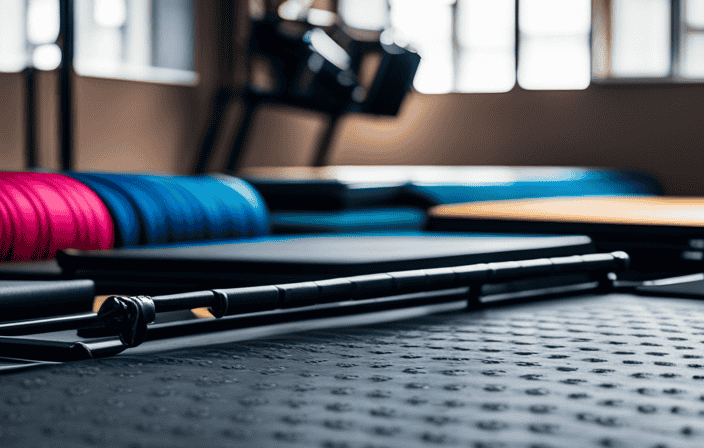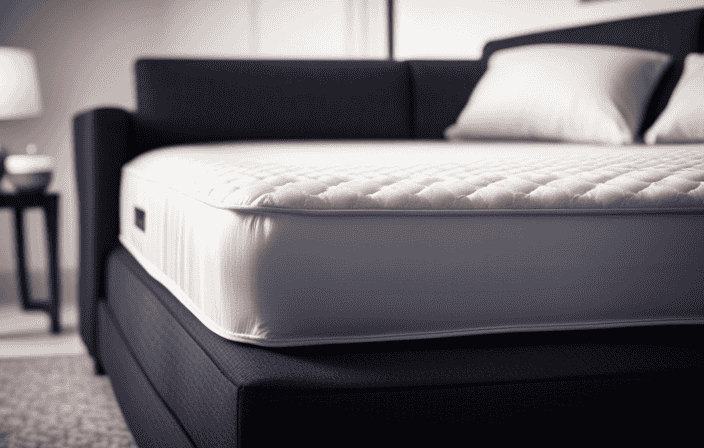You may be wondering, “Why invest so much time and energy in selecting the perfect Pilates mat?” Let me tell you, the correct mat can greatly enhance your Pilates routine.
In this article, we will explore the top Pilates mat options for 2023, considering features, materials, and benefits. Whether you’re a beginner or a seasoned practitioner, finding the perfect mat is essential for comfort, stability, and injury prevention.
So, let’s dive in and discover the best options that will enhance your Pilates experience this year.
Key Takeaways
- The BalanceFrom High-Density Pilates Mat and Manuka PRO Yoga and Pilates Mat are two of the best pilates mats in 2023.
- The BalanceFrom mat is exceptionally resilient and durable, made with 100mm thick foam for comfort on hard floors, and has a double-sided non-slip surface for slip resistance and injury prevention.
- Factors to consider when choosing a pilates mat include size, material, thickness, bottom texture, and top texture.
- Pilates mats are commonly made with NBR, PVC, or memory foam, and it’s important to choose a mat that is moisture resistant, safe, and easy to clean. Thicker mats provide extra padding for spine protection and joint comfort, and textured bottom mats stabilize movement during Pilates and reduce the risk of injuries.
Top Pilates Mat Options
I’ve researched the best Pilates mats for 2023, and two top options are the BalanceFrom High-Density Pilates Mat and the Manuka PRO Yoga and Pilates Mat.
The BalanceFrom mat is exceptionally resilient and durable, made with 100mm thick foam for comfort on hard floors. It has a double-sided non-slip surface for slip resistance and injury prevention, and it is lightweight at 2 lbs with a useful strap for easy carrying. The mat is moisture-resistant and easy to wash with soap and water, and it offers excellent non-slip traction and 10mm thick extra cushion.
On the other hand, the Manuka PRO mat is known for its high-density foam material and comes with a free carrying strap. It is thick enough to cushion knees and spine during yoga or Pilates and is a great option despite the initial chemical smell.
Size and Dimensions
When considering a Pilates mat, it is important to choose the appropriate size and dimensions for your body type. A mat that is too small may restrict your movement, while a mat that is too large can be cumbersome and difficult to transport.
The standard size for a Pilates mat is 24 inches wide and 68 inches long, but there are variations available to accommodate different body types. It is also important to consider the thickness of the mat. Thicker mats provide extra cushioning for your knees and spine, while thinner mats are ideal for improving balance.
Ultimately, the size and dimensions of your Pilates mat should allow you to move freely and comfortably during your practice.
Material Considerations
One important factor to consider when choosing a Pilates mat is the material used. The material of the mat can greatly affect its performance and durability. Here are some key considerations when it comes to choosing the right material for your Pilates mat:
-
NBR: This material is commonly used for Pilates mats due to its excellent cushioning and shock-absorption properties. It provides a comfortable surface for your workouts and helps protect your joints.
-
PVC: PVC mats are known for their durability and non-slip surface. They are easy to clean and maintain, making them a popular choice among Pilates enthusiasts.
-
Memory foam: Memory foam mats contour to the shape of your body, providing customized support and comfort. They are especially beneficial for those with joint or back pain.
-
Eco-friendly options: If sustainability is important to you, there are Pilates mats available that are made from eco-friendly materials such as natural rubber or cork.
Consider these material options when choosing your Pilates mat to ensure maximum comfort and performance during your workouts.
Thickness and Padding
The thickness and padding of the Pilates mat are important considerations for comfort and support during workouts. A thicker mat offers extra cushioning for the spine and joints, reducing the risk of discomfort or injury. It provides a comfortable surface for exercises that involve lying down or kneeling, such as rolling exercises or ab work. A thicker mat also helps protect joints during high-impact movements, making it suitable for more intense Pilates workouts.
In addition to thickness, the padding of the mat is crucial for providing support and stability. It helps distribute body weight evenly, preventing pressure points and ensuring a comfortable practice. Look for mats with high-density foam or memory foam for superior padding and support.
Bottom Texture Benefits
I prefer Pilates mats with a textured bottom because they provide stability, prevent slipping, reduce the risk of injuries, and increase my confidence during practice.
The textured bottom of a mat is designed to grip the floor, which helps to prevent the mat from sliding around during movements. This stability is crucial for maintaining proper form and alignment during Pilates exercises.
Additionally, the textured surface creates friction between the mat and the body, reducing the risk of slipping and allowing for more controlled movements. This not only helps to prevent injuries but also enhances the effectiveness of the workout.
The increased confidence that comes from using a textured bottom mat allows me to fully focus on my practice without worrying about slipping or losing balance.
Cleaning and Maintenance
To keep my Pilates mat clean and well-maintained, I make sure to regularly wash it with soap and water. This helps to remove any sweat, dirt, or bacteria that may have accumulated during my workouts.
Additionally, I take the following steps to ensure the longevity of my mat:
-
I avoid using harsh chemicals or abrasive scrub brushes when cleaning my mat, as this can damage the material.
-
After washing, I allow my mat to air dry completely before rolling it up for storage, as moisture can lead to mold or mildew.
-
To prevent the buildup of odors, I occasionally sprinkle baking soda on my mat and let it sit for a few minutes before wiping it off.
-
I store my mat in a cool, dry place away from direct sunlight, as prolonged exposure to heat can cause the material to deteriorate.
By following these simple cleaning and maintenance practices, I can enjoy a clean and hygienic Pilates mat for years to come.
Eco-friendly Options
When considering eco-friendly choices, it is important to look for mats made from sustainable materials. These mats not only benefit the environment but also provide a safe and healthy option for your Pilates practice. There are several eco-friendly materials used for Pilates mats, including natural rubber, cork, and jute. These materials are renewable, biodegradable, and free from harmful chemicals. They also offer excellent grip and durability.
Here is a comparison table of some popular eco-friendly Pilates mats:
| Mat Name | Material | Features |
|---|---|---|
| Manduka eKO Mat | Natural Rubber | Made from biodegradable materials, superior grip, dense cushioning |
| Liforme Yoga Mat | Natural Rubber and Sustainable Cork | Non-slip surface, alignment system, eco-friendly materials |
| Yoloha Native Cork Yoga Mat | Sustainable Cork | Naturally antimicrobial, non-toxic, lightweight |
| Jade Harmony Mat | Natural Rubber | Sustainable, great grip, supportive cushioning |
| Prana Revolution Mat | Natural Rubber and Jute | Durable, non-toxic, excellent traction |
By choosing an eco-friendly Pilates mat, you are not only taking care of your own well-being but also contributing to a healthier planet.
Choosing the Right Mat
One important factor to consider in choosing the right mat is the thickness, which can provide different benefits for your Pilates practice.
Thinner mats are great for improving balance, as they provide a stable surface for your movements. They also tend to be lighter and easier to carry around.
On the other hand, thicker mats offer extra padding for spine protection and joint comfort. They are particularly beneficial for exercises that require you to lie down or put pressure on your back, such as roll-ups or the spine stretch.
Additionally, textured bottom mats are worth considering as they help stabilize movement during Pilates, prevent slipping, reduce the risk of injuries, and increase confidence during practice.
It’s important to choose a mat that suits your needs and preferences to enhance your Pilates experience.
Frequently Asked Questions
Are there any specific cleaning instructions for maintaining a pilates mat?
To maintain a Pilates mat, I recommend cleaning it regularly with soap and water. Gently scrub the surface, rinse thoroughly, and allow it to air dry. Avoid using harsh chemicals or abrasive materials that may damage the mat.
What are some eco-friendly options for pilates mats?
Some eco-friendly options for Pilates mats include those made from natural rubber, cork, or recycled materials. These mats are not only better for the environment but also offer the same level of comfort and functionality as traditional mats.
How do I choose the right size and dimensions for a pilates mat?
To choose the right size and dimensions for a Pilates mat, consider your body type and the space you have available. Opt for a mat that provides enough room for your body to move comfortably and allows for proper alignment during exercises.
What are the benefits of using a textured bottom mat during pilates?
Using a textured bottom mat during Pilates provides stability, prevents slipping, reduces the risk of injuries, and increases confidence during practice. It stabilizes movement, making it easier to perform exercises with control and precision.
Can you provide more information on the different materials used for pilates mats and their advantages/disadvantages?
Sure! When it comes to pilates mats, common materials include NBR, PVC, and memory foam. These materials are chosen for their moisture resistance, safety, and easy cleaning. Additionally, there are eco-friendly and sustainable options available.
Conclusion
In conclusion, when it comes to choosing the best Pilates mat for 2023, the BalanceFrom High-Density Pilates Mat and the Manuka PRO Yoga and Pilates Mat are top contenders.
Both mats offer excellent features and benefits such as durability, non-slip surfaces, and extra cushioning for comfort and injury prevention.
Factors to consider when choosing a mat include size, material, thickness, and bottom texture. Additionally, it is important to choose a mat that is moisture resistant, easy to clean, and eco-friendly.
So, make sure to find the perfect mat that suits your needs and enjoy your Pilates practice to the fullest! And remember, PMA (Pilates Mat Always) for a strong and balanced body!










